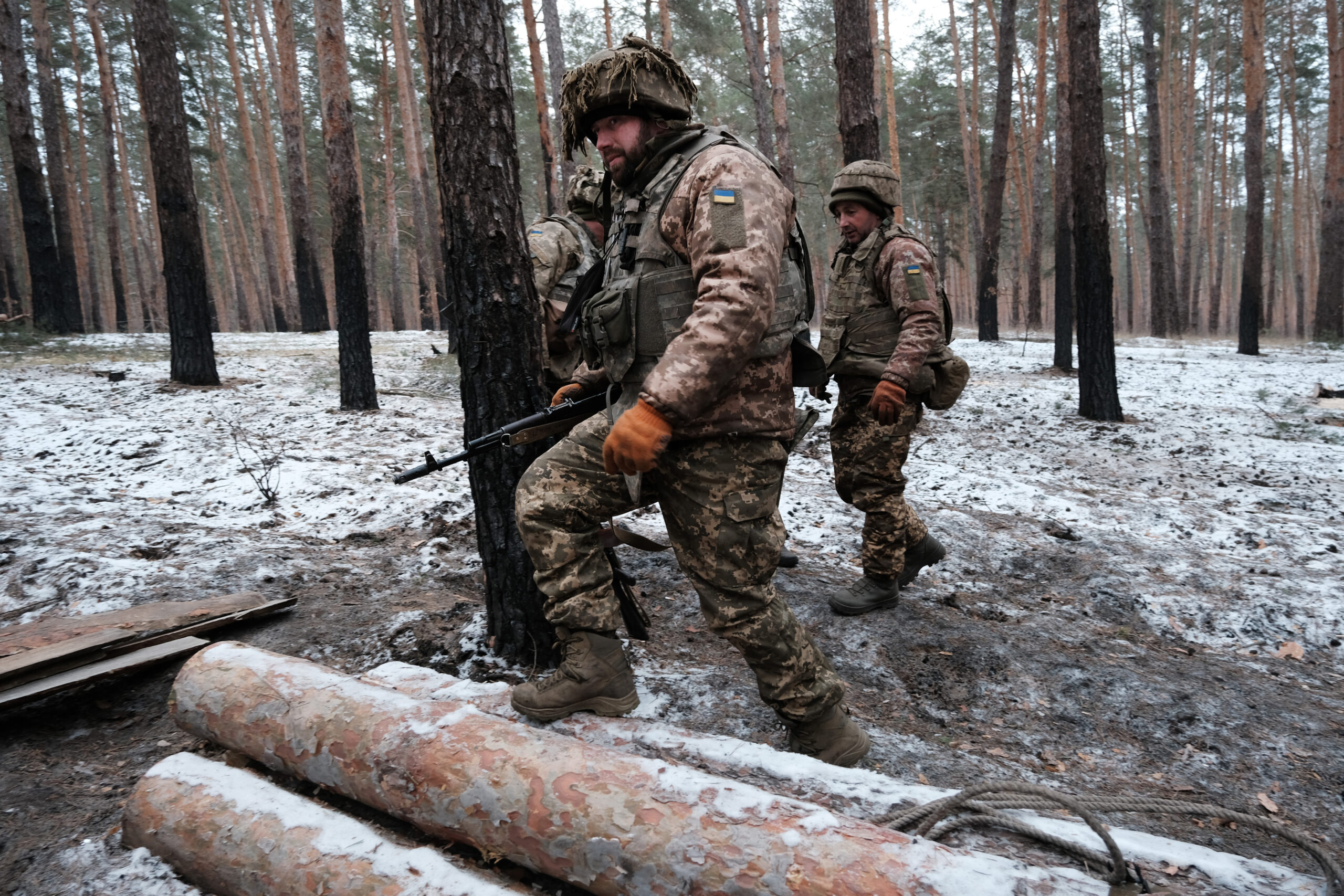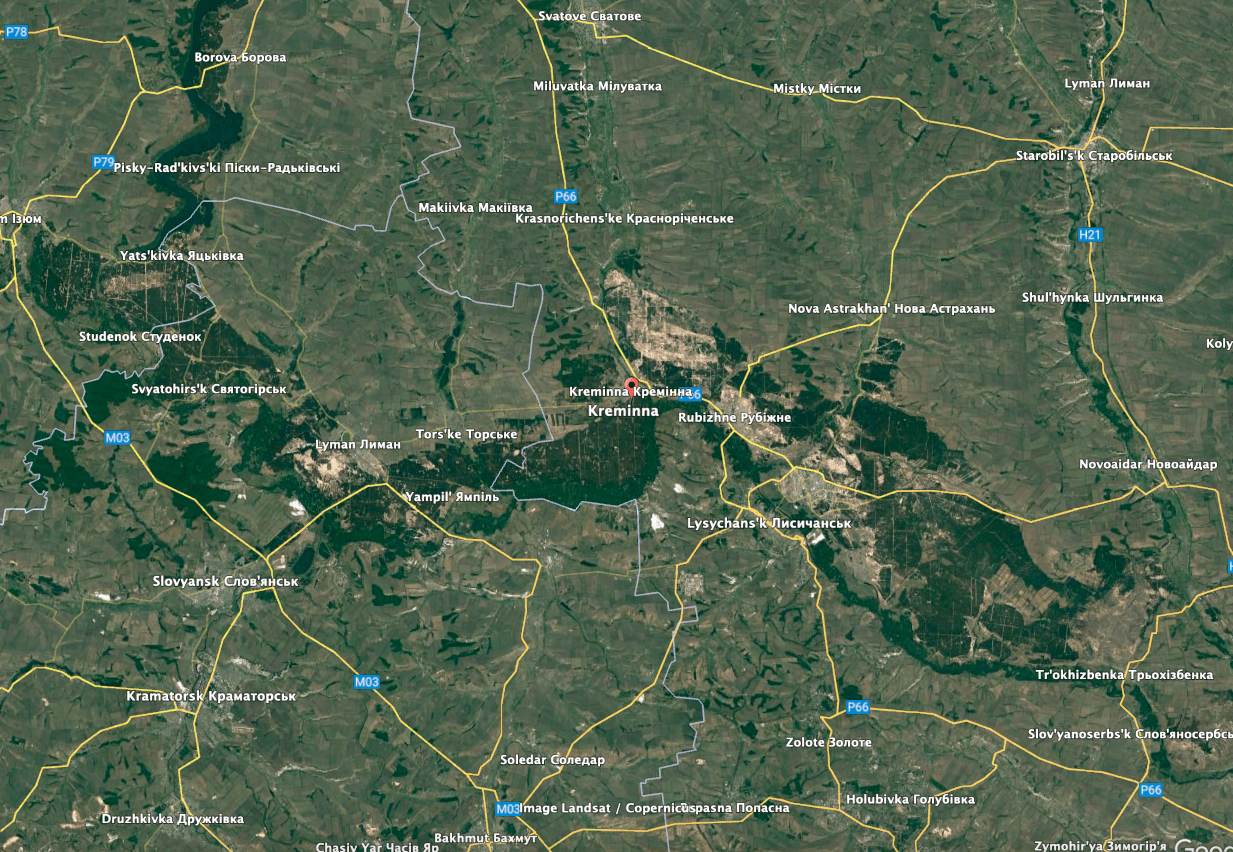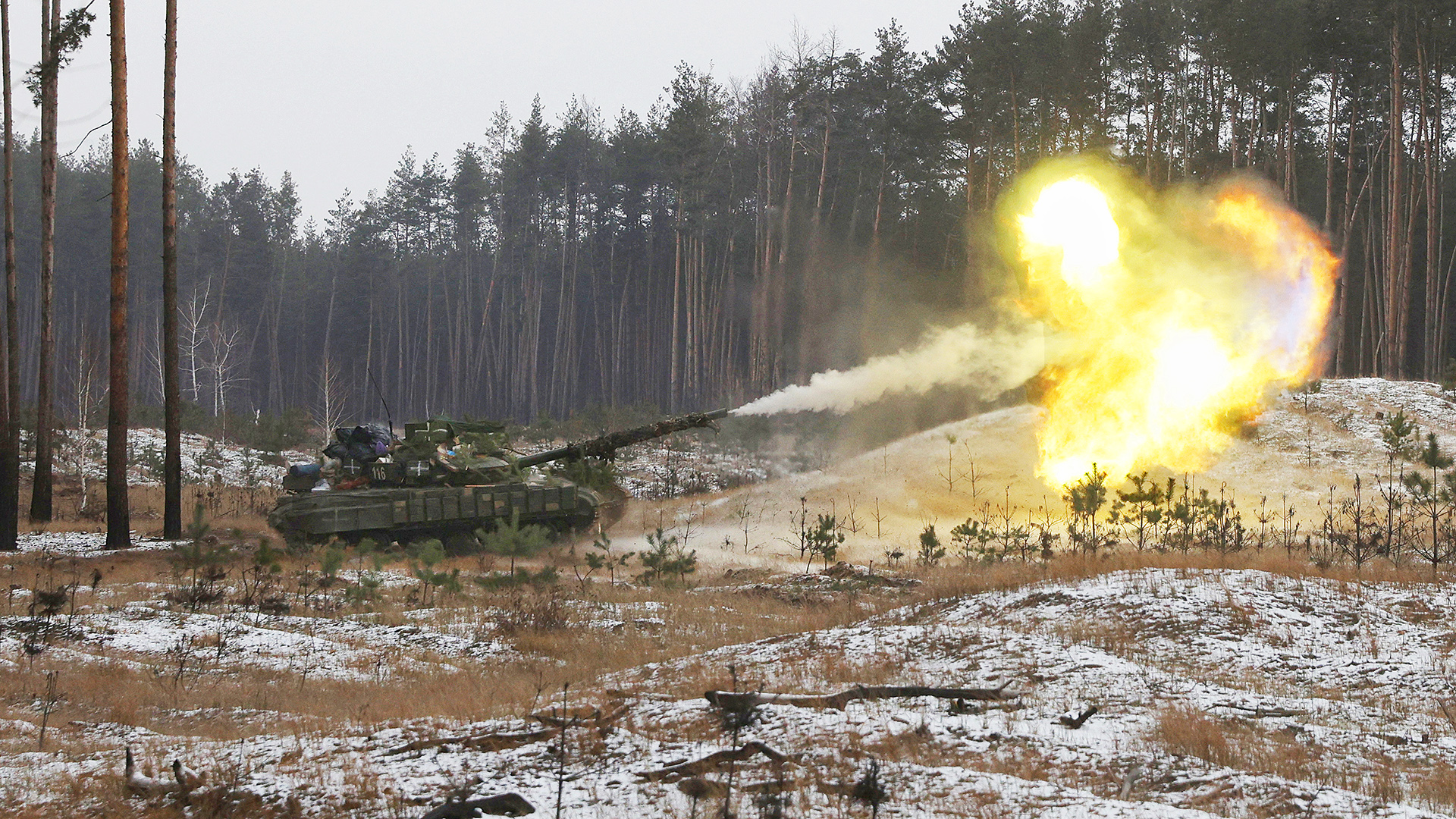In a war that has ground down to a bloody static slog, an ongoing counteroffensive by Ukrainian forces in the small city of Kreminna has the potential of breaking things open in the Donbas.
“Kreminna is a gateway to the north and central Luhansk region,” a Ukrainian military advisor told The War Zone on Monday. “And it allows us to hit the flank of Bakhmut,” the embattled city in Donetsk Oblast, located some 30 miles to the southwest.

The assessment of the advisor, who spoke on the condition of anonymity to discuss tactical operations, was shared Sunday by Serhiy Hayday, the Ukrainian governor of Luhansk Oblast.
“Meter by meter, our defenders are de-occupying the Luhansk Region,” Hayday said on his Telegram channel. “When the Armed Forces of Ukraine liberate Kreminna, the way to Rubizhne and Severodonetsk will open. And there is a possibility that the Russians will flee from the temporary regional center when we get close to Severodonetsk.”
Kreminna sits about midway along the P-66 Highway, a key roadway running from Svatove in the north and to Novoaidar to the east.
“We maintain fire control over the Svatove-Kreminna highway,” Hayday wrote. “Ork [Russian] logistics are significantly disrupted.”

The biggest impediment at the moment to recapturing Kreminna is “the dense minefield of the territory,” Hayday said.
Kreminna was the first city to fall when Russia relaunched its Donbas offensive in April after Moscow’s initial plan to conquer Kyiv failed. And now it is one of the two hottest areas being contested across a long front running from the Kinburn Spit in Mikolaiv Oblast to the Donbas, a senior U.S. military official said Monday.
“The situation along the front lines in Ukraine continues to remain largely static, with the exceptions being Ukraine’s counter-offensive operations efforts near Kreminna and Russia’s continued efforts to try to take territory near Bakhmut,” the official, speaking on condition of anonymity, told reporters, including from The War Zone. “In both areas, the situation remains fluid with a lot of back and forth. It is important to note however that Ukrainian forces continue to successfully hold and defend Bakhmut.”
The official told The War Zone that Ukrainian forces are making “some incremental gains” in their efforts to recapture Kreminna, where more than 18,000 people used to live before Russia’s full-on invasion. “It is just one example of the Ukrainians looking to exploit opportunities along the Russian defensive lines, and our focus is on trying to get them the security assistance they need to be able to take advantage and exploit those kinds of opportunities.”
The Kreminna offensive comes as Russian forces are attempting to “refit, recruit and reinitiate operations,” the official said, ahead of a potentially looming new wave of attacks in the spring.
And while the U.S. is training about 500 Ukrainian troops on combined arms maneuvers in Germany, the official said that the Kreminna offensive shows that Ukraine is not waiting for those troops to cycle through the training to attack.
Ukraine’s hold on Bakhmut, where both sides are taking tremendous casualties, is tenuous, however.
The senior U.S. military official declined to comment on last week’s assessment by German intelligence that Ukraine is losing “a three-digit number of soldiers every day” defending Bakhmut.
When asked to confirm a statement Norwegian Defense Minister Eirik Kristoffersen made Sunday to Norway’s TV2 that “Russian losses are beginning to approach around 180,000 dead or wounded soldiers,” the official deferred to comments made by Army Gen. Mark Milley, chairman of the Joint Chiefs of Staff on Friday, that Russia has suffered “significantly well over” 100,000 casualties.
To the Ukrainians, Bakhmut is important not only because it is their country, but because even at a high cost, they are keeping the Russians bogged down and bleeding. Russia is largely relying on the Wagner mercenary group in Bakmut, but is also pouring in tens of thousands of additional troops across all the front lines, the senior U.S. official said.
How all this affects Ukraine’s larger strategic goal of liberating the entire country, including Crimea, remains unknown and the senior U.S. military official declined to speculate.
Before we dive into the latest updates from Ukraine, The War Zone readers can get caught up on our previous rolling coverage here.
The Latest
The seemingly never-ending saga of whether Ukraine will receive more modern tanks continues.
Poland’s Prime Minister Mateusz Morawiecki on Monday said that his nation will seek permission from Germany to send Ukraine Leopard 2 tanks. Because Berlin holds the export licenses on those German-made tanks, it has to give its approval before they can be transferred. But even if that permission is not granted, Poland will join several other nations and send them anyway, Morawiecki said, according to Reuters.
On Sunday, Germany’s Foreign Minister Anna Baerbock said she “would not stand in the way” of Poland if it were to send Leopard 2 tanks to Ukraine, though at the time Poland had yet to officially ask. However, it is German Chancellor Olaf Scholz who has the ultimate say in the matter, and so far, he has not agreed to sign off on the deal.
There is no shortage of those weapons in Europe. NATO nations have more than 2,300 Leopard 2 tanks in their stocks, according to the International Institute for Strategic Studies. But last week, no consensus was reached about providing any to Ukraine at the Defense Contact Group meeting of some 50 nations seeking to arm Kyiv in its fight against Russia. You can read more about the weapons that have been provided and promised to Ukraine, including U.K. Challenger 2 tanks, here.
However, a group of 12 countries has agreed to supply Ukraine with around 100 Leopard 2 tanks if the German government gives its consent, a senior Ukrainian official told ABC News in an exclusive interview.
Those agreements, the source said, were made at Friday’s summit at Ramstein U.S. Air Force Base in Germany, when allied nations discussed military support for Ukraine.
German Defense Minister Boris Pistorius defended Berlin’s cautious approach to providing Leopard 2 tanks to Ukraine on Monday.
“It’s not just a question of delivering or not delivering these tanks, but also weighing up the consequences of not acting, but also of acting,” he told the German ARD TV network.
As a “‘Leopard’ nation,” Germany has a special responsibility “that we have to live up to,” said the minister. The “Leopard” is a heavy armored weapon that can also be used for offensive purposes. “And you have to think very carefully about when you bring them into this event.” He thinks it’s in Germany’s and Europe’s interest to do this carefully and in a balanced manner, “and not in haste or frivolously.”
U.S. State Department spokesman Ned Price said on Monday that based on recent headlines, a decision might be forthcoming.
“My impression having seen headlines that are just emerging is that we may be hearing more from our German allies in the coming hours, in the coming days,” he told reporters.
U.S. M-1 Abrams tanks, meanwhile, are still not on the table for Ukraine, the senior U.S. military official said Monday, once again citing Washington’s long-standing concerns about the high-end and logistically challenging American main battle tanks.
About 20 T-72B tanks provided by Morocco and refurbished in the Czech Republic have found their way onto the battlefield, the MenaDefense news agency reported Sunday.
The senior U.S. defense official on Monday could not comment on that claim.
While the tank debate rages on, Estonia promised to send all its 155mm howitzers to Ukraine as part of a $123 million aid package, according to the Ukrainian Armed Forces General Staff Facebook page.
“We give all our 155 mm howitzers to Ukraine,” Estonian Ambassador to Ukraine Kaimo Kuusk said, according to the Ukrainian General Staff Facebook page. “And we want to set a precedent in such a way that other countries have no excuses left [as to] why they cannot provide Ukraine with the necessary weapons to win the war.
The package includes dozens of 155mm FH-70 and 122mm D-30 howitzers, thousands of 155 mm shells, and hundreds of Karl-Gustaf anti-tank weapons and ammunition.
While they gave the howitzers and ammo to Ukraine, Estonia hopes to recoup some $435 million from a European Union fund, for arms aid the country has provided to Ukraine, the Estonian ERR news agency reported Monday.
The European Peace Facility (EPF), was set up for the period 2021-2027 before Russia’s full-scale invasion of Ukraine started nearly a year ago, meaning the nearly $6.5 billion allocated is not sufficient to cover all EU member states expenditure on military aid to Ukraine (which is nearly double that sum for 2022 alone), ERR reported. Only a little more than a quarter of the total sum Estonia has requested is confirmed.
Reimbursement for the most recent aid package of howitzers and ammunition to Ukraine will be requested soon, ERR reported.
And on the sea, Ukrainian sailors are training on two Sandown-class minesweeper ships that formally belonged to the Royal Navy, according to the UK Defence Journal.
The minehunters, now named the Chernhiv and the Cherkasy, are currently conducting training and recently sailed together for the first time under the Ukrainian flag, the UK Defence Journal reported. They are conducting routine training to familiarize their new crews with their systems.
The vessels are designed for the clearance of mines in shallow coastal waters, and are constructed of glass-reinforced plastic to reduce their magnetic and acoustic signatures, making them harder to detect by mines, according to the publication. The ships can be fitted with remote-controlled mine disposal vehicles to neutralize mines.
So far, the Biden administration has provided Ukraine with more than $113 billion worth of weapons and other support in its fight against Russia.
To keep an eye on those donations, the Pentagon, State Department and U.S. Agency for International Development inspectors general last week unveiled the Joint Strategic Oversight Plan for Ukraine Response (JSOP).
“Oversight of all U.S. Government Ukraine response efforts is critical to ensure proper use of these funds and to detect and deter fraud, waste, and abuse,” JSOP said in the intro to its 42-page document. “The DoD, State, and USAID OIGs are committed to leading the oversight community in prioritizing this oversight.”
As part of this effort, dozens of reviews are underway to ensure that the funds are properly spent.
Days after that report was released, Ukrainian President Volodymyr Zelensky on Sunday said that corruption would not be tolerated and promised forthcoming key decisions on uprooting it this week, according to Reuters.
Zelenskiy’s pledge came amidst allegations of senior-level corruption, including a report of dubious practices in military procurement.
It also came in the wake of news reports saying an acting deputy minister of regional development, Vasyl Lozinskiy, was detained on allegations of accepting a bribe, according to Reuters.
Ukraine’s Defence intelligence states that Russia has up to 550 high precision missiles left, or about 20% of its pre-war stockpile, so it combines them with kamikaze drones and modifies S-300 and S-400 anti-aircraft missiles for surface-to-surface launches, according to the Ukrainian Ukrainska Pravda news agency.
We see a lot of videos of both Ukrainian and Russian helicopters striking targets. But follow along with this geolocated thread from the @RedIntelPanda OSINT handle to see details about where the Russians launched this attack they recorded and where it took place.
Ukrainian helicopters put on a show of their own, which you can see in this video below.
The Lviv Journal shared a surreal-looking video showing what it said may have been the aftermath of a Russian airstrike using the incendiary agent white phosphorous. While the use of white phosphorus is extremely controversial and is prohibited in certain circumstances under international treaties, it does not meet the definition of a chemical weapon according to the Chemical Weapons Convention.
And finally, an anti-drone net was apparently able to save a Ukrainian Krab howitzer from an attack by a Russian drone.
That’s it for now. We will update this story if there is anything major to add.
Contact the author: howard@thewarzone.com
